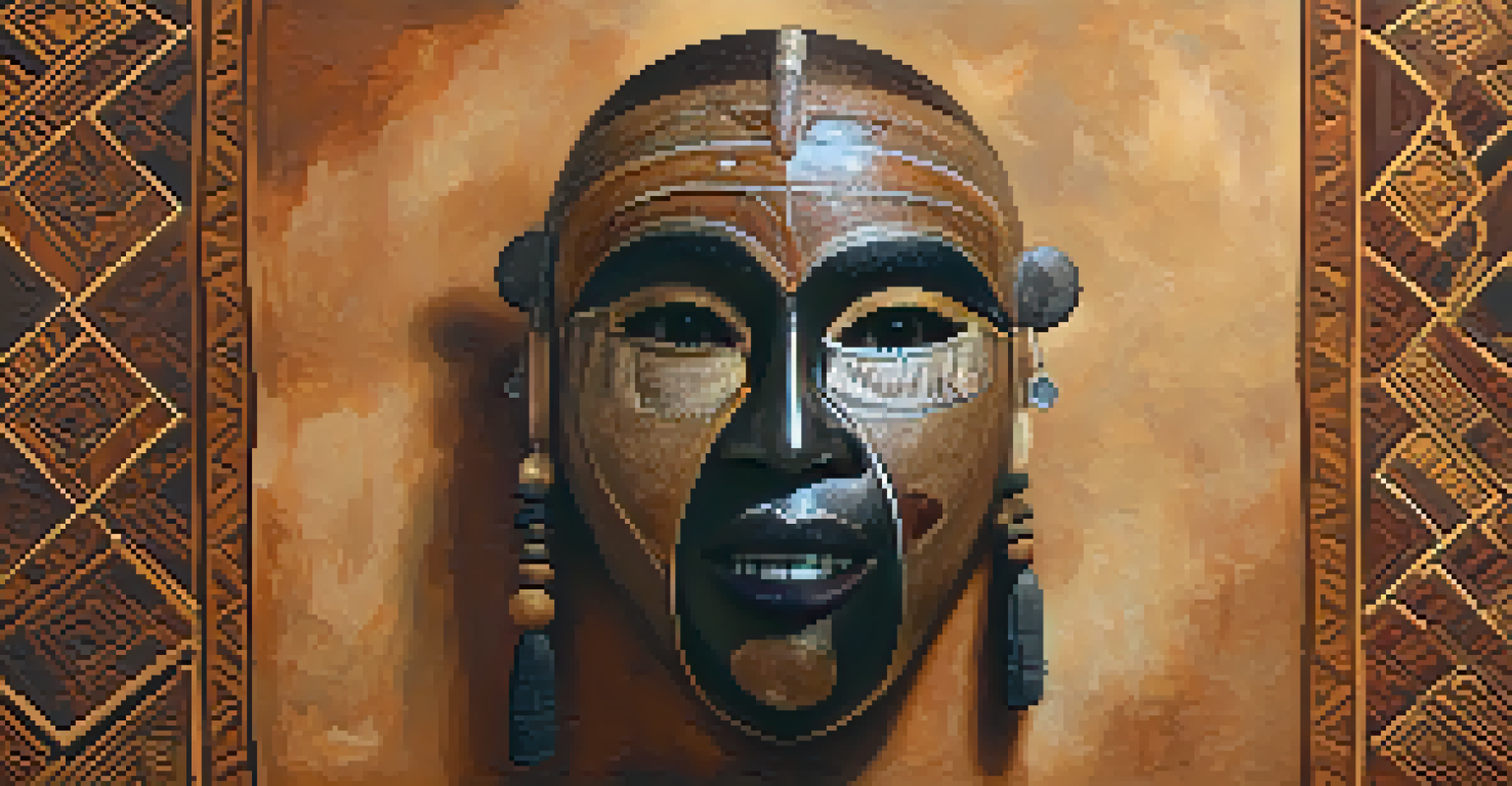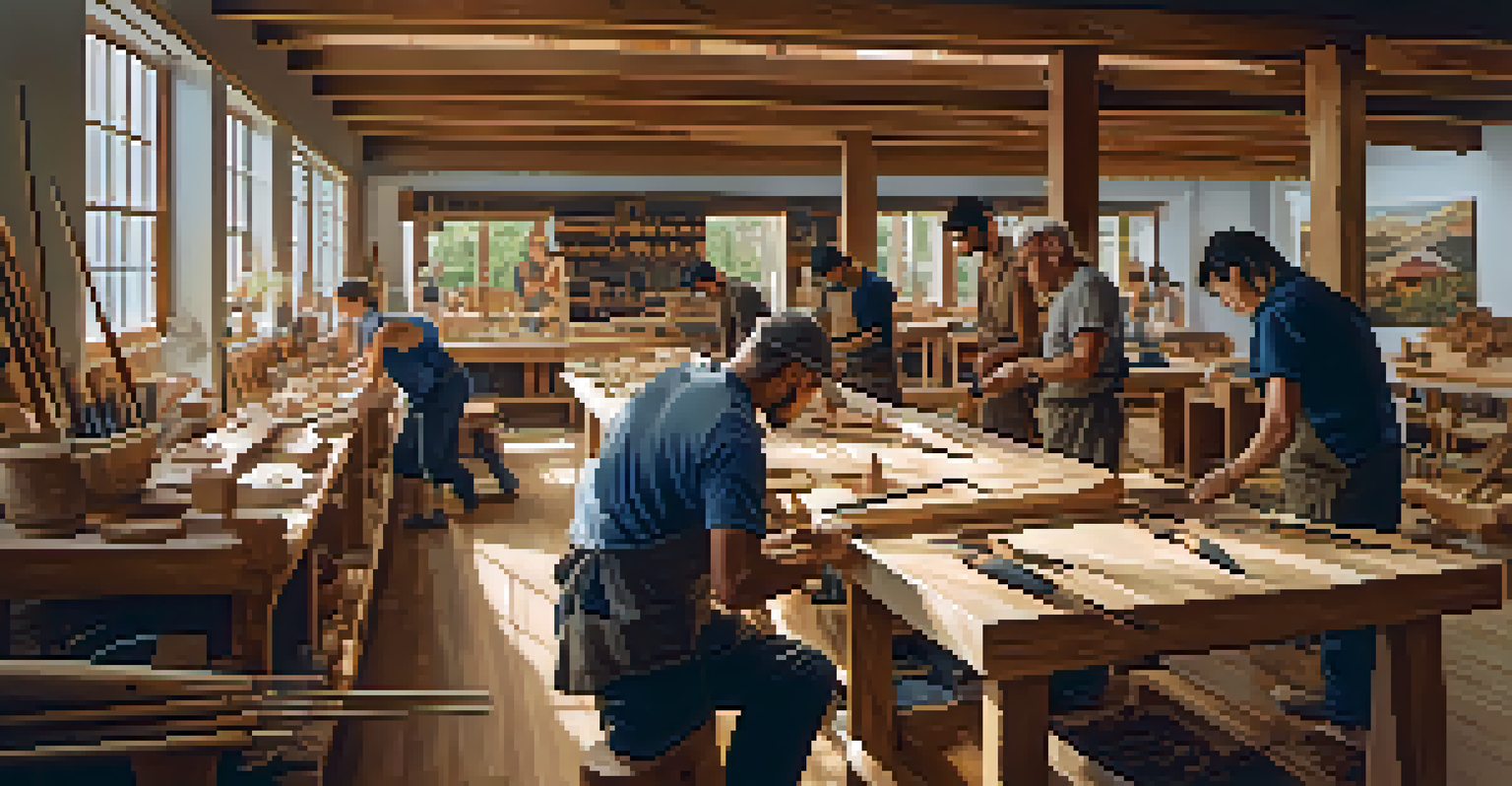Carving and Ancestor Worship: A Spiritual Link

The Art of Carving: A Cultural Heritage
Carving is more than just creating shapes from wood or stone; it's a reflection of cultural identity. Throughout history, various cultures have used carving to tell stories, preserve traditions, and express their beliefs. Each piece carries the weight of history, often depicting ancestral figures or significant events.
Art is the most beautiful of all lies; it is a reflection of our deepest truths.
In many societies, carving serves as a conduit for connecting with the past. For instance, Native American totem poles not only showcase artistic skill but also honor ancestors and convey vital tribal narratives. Similarly, African masks are carved to represent spirits, celebrating the lineage and cultural heritage.
This artistic practice is a powerful reminder of where we come from. By engaging in carving, individuals participate in a long-standing tradition, linking themselves to previous generations and ensuring that their stories are not forgotten.
Understanding Ancestor Worship: A Spiritual Connection
Ancestor worship is the practice of honoring those who came before us, and it plays a vital role in many cultures worldwide. This spiritual connection often manifests in rituals, offerings, and memorials, all aimed at showing respect and gratitude. The belief is that ancestors continue to influence the lives of their descendants.

In various traditions, such as Chinese and African cultures, ancestor worship serves as a way to maintain family bonds and uphold cultural values. By honoring ancestors, individuals seek guidance and blessings for the future, creating a continuous cycle of respect and reverence.
Carving as Cultural Identity
Carving serves as a significant reflection of cultural heritage, telling stories and preserving traditions through artistic expression.
This practice not only strengthens familial ties but also fosters a sense of belonging. It reminds people that they are part of a larger narrative, interwoven with the lives and experiences of those who came before them.
The Intersection of Carving and Ancestor Worship
Carving and ancestor worship often intertwine, as carved objects frequently serve as vessels for honoring ancestors. Through the creation of statues, masks, or totem poles, artists channel their respect and gratitude into tangible forms. Each piece becomes a tribute, bridging the gap between the living and the spirits of the departed.
The past is never dead. It's not even past.
For example, in many Pacific Island cultures, carving a canoe or a figure often reflects ancestral stories or traits, ensuring that the wisdom and courage of forebears live on. These creations are not merely decorative; they embody the spirit and values of the ancestors, fostering a deep connection between generations.
This synergy underscores the significance of creativity in spiritual practices. By engaging in carving, individuals not only express their artistic abilities but also contribute to a rich tapestry of cultural and spiritual heritage.
Symbolism in Carving: More Than Meets the Eye
Carvings often carry deep symbolic meanings that resonate with spiritual beliefs. Different shapes, figures, and materials used in carving can represent various aspects of the human experience, such as life, death, and rebirth. Understanding these symbols enriches our appreciation of the art and its connection to ancestor worship.
For instance, a serpent might symbolize transformation and healing in some cultures, while in others, it may represent the connection between the physical and spiritual realms. Recognizing these symbols allows individuals to engage more profoundly with the art and its intended message.
Ancestor Worship Strengthens Bonds
Honoring ancestors through rituals and carvings fosters familial connections and a sense of belonging within cultural narratives.
Thus, each carved piece becomes a storytelling medium, inviting viewers to explore its significance and reflect on their own beliefs about ancestry and spirituality.
The Role of Rituals in Carving and Worship
Rituals play a crucial role in both carving and ancestor worship, often serving as a means to honor and connect with the spiritual world. Many cultures incorporate specific ceremonies when creating carved objects, imbuing the process with sacred significance. These rituals can include prayers, offerings, or blessings to invite ancestral spirits into the creation.
For example, in some Indigenous cultures, a carving ceremony may involve the entire community, reinforcing collective identity and shared values. This communal aspect not only strengthens bonds among participants but also heightens the spiritual energy surrounding the creation.
As such, the act of carving becomes a transformative experience, allowing artists to channel their intentions and connect with their heritage on a deeper level.
Contemporary Carving: A Modern Expression of Tradition
Today, contemporary carving continues to evolve, blending traditional techniques with modern concepts. Artists are exploring new materials and styles while maintaining a connection to their cultural roots. This fusion creates a dynamic dialogue between the past and present, allowing for innovative expressions of ancestral reverence.
For example, some artists incorporate recycled materials into their work, symbolizing sustainability and respect for the environment, which mirrors ancestral teachings about living in harmony with nature. This approach not only honors the past but also addresses contemporary issues, making the art relevant to today’s audience.
Contemporary Carving Preserves Legacy
Modern carving practices blend traditional techniques with new concepts, ensuring the legacy of ancestor worship remains vibrant and relevant.
By adapting traditional practices to modern contexts, contemporary carvers ensure that the legacy of ancestor worship remains vibrant and accessible, inviting new generations to engage with their heritage.
Preserving Ancestral Legacies Through Carving
Preservation of ancestral legacies is vital as societies continue to change and evolve. Carving serves as a means to safeguard these narratives, ensuring that future generations understand their roots and cultural identity. By creating and sharing carved works, artists contribute to a living history that honors the past.
Many communities are now focusing on passing down carving techniques to younger generations, creating mentorship programs that foster skills and appreciation for their heritage. This transfer of knowledge not only preserves the art form but also reinforces the importance of ancestor worship in contemporary life.

Through carving, individuals are empowered to express their identities, keeping the memories of their ancestors alive. This dynamic process of preservation helps bridge the gap between the past and the present, allowing cultures to thrive.